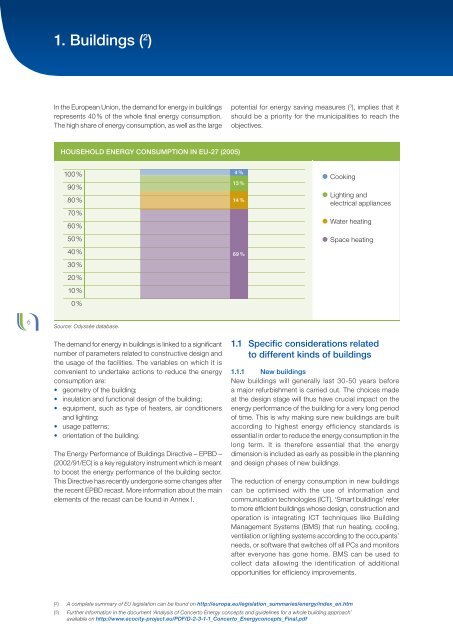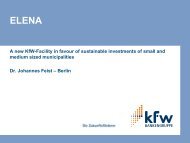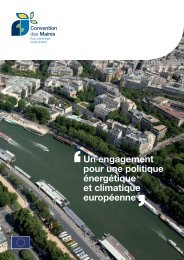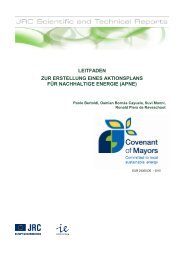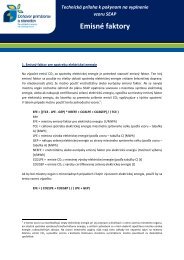1. Buildings ( 2 )In the European Union, the demand for energy in buildingsrepresents 40 % <strong>of</strong> the whole final energy consumption.The high share <strong>of</strong> energy consumption, as well as the largepotential for energy saving measures ( 3 ), implies that itshould be a priority for the municipalities to reach theobjectives.HOUSEHOLD ENERGY CONSUMPTION IN EU-27 (2005)100 %90 %80 %70 %60 %50 %40 %30 %20 %10 %0 %4 %13 %14 %69 %• Cooking• Lighting andelectrical appliances• Water heating• Space heating6Source: Odyssée database.The demand for energy in buildings is linked to a significantnumber <strong>of</strong> parameters related to constructive design andthe usage <strong>of</strong> the facilities. The variables on which it isconvenient to undertake actions to reduce the energyconsumption are:• geometry <strong>of</strong> the building;• insulation and functional design <strong>of</strong> the building;• equipment, such as type <strong>of</strong> heaters, air conditionersand lighting;• usage patterns;• orientation <strong>of</strong> the building.The Energy Performance <strong>of</strong> Buildings Directive – EPBD –(2002/91/EC) is a key regulatory instrument which is meantto boost the energy performance <strong>of</strong> the building sector.This Directive has recently undergone some changes afterthe recent EPBD recast. More information about the mainelements <strong>of</strong> the recast can be found in Annex I.1.1 Specific considerations relatedto different kinds <strong>of</strong> buildings1.1.1 New buildingsNew buildings will generally last 30-50 years beforea major refurbishment is carried out. The choices madeat the design stage will thus have crucial impact on theenergy performance <strong>of</strong> the building for a very long period<strong>of</strong> time. This is why making sure new buildings are builtaccording to highest energy efficiency standards isessential in order to reduce the energy consumption in thelong term. It is therefore essential that the energydimension is included as early as possible in the planningand design phases <strong>of</strong> new buildings.The reduction <strong>of</strong> energy consumption in new buildingscan be optimised with the use <strong>of</strong> information andcommunication technologies (ICT). ‘Smart buildings’ referto more efficient buildings whose design, construction andoperation is integrating ICT techniques like BuildingManagement Systems (BMS) that run heating, cooling,ventilation or lighting systems according to the occupants’needs, or s<strong>of</strong>tware that switches <strong>of</strong>f all PCs and monitorsafter everyone has gone home. BMS can be used tocollect data allowing the identification <strong>of</strong> additionalopportunities for efficiency improvements.(2) A complete summary <strong>of</strong> EU legislation can be found on http://europa.eu/legislation_summaries/energy/index_en.htm(3) Further information in the document ‘Analysis <strong>of</strong> Concerto Energy concepts and guidelines for a whole building approach’available on http://www.ecocity-project.eu/PDF/D-2-3-1-1_Concerto_Energyconcepts_Final.pdf
Note that even if energy efficiency has been incorporatedat the start, a building’s actual energy performance can beimpaired if builders deviate from the plans or if occupantsdo not operate the BMS according to the plans orspecifications. Assuming the building has been designedand built to specification, poor commissioning (ensuringthat the building’s systems function as specified), constantchange <strong>of</strong> use and poor maintenance can significantlyreduce the effectiveness <strong>of</strong> any BMS. Provide bettertraining to building operators and information to users bysimple devices such as visual smart meters or interfacesto influence behavioural change.The Energy Services Companies’ (ESCO) scheme toimprove the energy efficiency performance may be appliedto all types <strong>of</strong> buildings <strong>of</strong> this subchapter. This schemeis explained in Part I (How to Develop a Sustainable EnergyAction Plan) financing chapter.1.1.3 Public buildingsPublic buildings are those owned, managed or controlledby the local, regional, national or European publicadministration.The buildings owned, controlled or managed by thelocal authority itself are those on which the local authorityhas the greatest control. Therefore, it is expected thatthe local authority will adopt exemplary measures in itsown buildings.When planning new constructions or renovations, the localauthority should set the highest energy standards possibleand ensure that the energy dimension is integrated intothe project. Energy performance requirements or criteriashould be made mandatory in all tenders related to newconstructions and renovations (see the public procurementpolicies point in Part I).1.1.2 Existing buildings undergoing majorrefurbishmentsWhen an existing building is subject to a majorrefurbishment, it is the ideal opportunity to improve itsenergy performance. In general between 1.5 % and 3 %<strong>of</strong> the building stock is renovated each year, so thatif energy performance standards are applied to suchrefurbishments, in a few years the energy performance<strong>of</strong> the entire building stock shall improve accordingly.This basic evidence has been translated into the EnergyPerformance <strong>of</strong> Buildings Directive and Member Stateshave to set up minimum standards for buildings subjectto major renovations. As for new buildings, the localauthority could play a role to improve the energy efficiency<strong>of</strong> renovated buildings.When considering large investments or refurbishments,it is recommended to make an energy audit in order toidentify the best options, allowing the reduction <strong>of</strong> theenergy consumption and preparation <strong>of</strong> an investmentplan. Investments may be limited to a building component(replacement <strong>of</strong> an inefficient heating boiler) or may berelated to the complete refurbishment <strong>of</strong> a building(including building envelope, windows …). It is importantthat the investments are planned in a proper manner(e.g. first reducing heat demand by dealing with theenvelope and then placing an efficient heating system,otherwise the dimensioning <strong>of</strong> the heating system will beinappropriate, which results in unnecessary investmentcosts, reduced efficiency and greater energy consumption).Different possibilities do exist, which can be combined:• Refer to the global energy performance norms existingat national/regional level ( 4 ) and impose strong minimumglobal energy performance requirements (i.e. expressedin kWh/m 2 /year, passive, zero energy, …). This leavesall the options open to the building designers to choosehow they will reach the objectives (provided they knowhow to do it). In principle, architects and buildingdesigners should be familiar with those norms, as theyapply to the entire national/regional territory.• Impose a certain quantity <strong>of</strong> renewable energyproduction.• Request an energy study that will help to minimisethe energy consumption <strong>of</strong> the building consideredby analysing all major options to reduce energy, as wellas their costs and benefits (reduced energy bill,better comfort, …).• Include the building’s projected energy consumption asan award criterion in the tender. In this case, energyconsumption should be calculated according to clearand well defined standards. A transparent system <strong>of</strong>points could be included in the tender: (ex: zero kWh/m²= 10 points; 100 kWh/m² and above = 0 points).• Include the cost <strong>of</strong> energy consumption over the next20-30 years in the cost criteria in the tender (do notconsider the building construction cost alone). In thiscase, hypotheses related to future energy prices haveto be set and energy consumption should be calculatedaccording to clear and well defined standards.7(4) In the context <strong>of</strong> the Energy Performance <strong>of</strong> Buildings Directive (2002/91/EC), all member States are obliged to set up a method to calculate/measure the energy performance <strong>of</strong> buildings and to set minimum standards.


